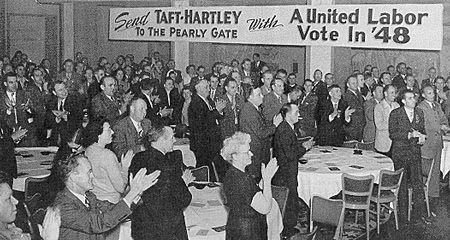
June 5, 2025 — While the United States has some of the most progressive labor laws in the world, there have been numerous attempts by the federal government to weaken the rights and liberties afforded to labor unions.
The Taft-Hartley Act of 1947 is considered the first major union-busting law. It was introduced in the U.S. Senate by Ohio Senator Robert Taft and in the House of Representatives by New Jersey Congressman Fred Hartley, Jr.
The bill revised the National Labor Relations Act, which established the right for unions to organize and gave rise to the National Labor Relations Board (NLRB). Taft-Hartley granted the board new powers to act against unions if they deemed that their activities constituted “unfair labor practices.” The act also allowed states to adopt “right to work” laws.
Despite a veto by U.S. President Harry Truman and his warning that the Taft-Hartley Act represented a “dangerous intrusion of free speech,” Congress overrode the president and passed the act on June 23,1947.
In addition to empowering union-busting by the NLRB, Taft-Hartley gave the president the power to seek legal recourse to end a strike if it was deemed a matter of national emergency and it prohibited federal employees from striking. Finally, the act repealed a part of the National Labor Relations Act that required an employer to remain neutral when employees seek the right to organize. Instead, Taft-Hartley allowed employers to oppose unionization attempts and even petition the NLRB to challenge unions if they represented the majority of employees at a company.
These provisions were not only a response to growing organized labor activity and influence, but also a response to major strikes happening throughout the country in 1945 and 1946.
Despite the passage of Taft-Hartley, unions were not deterred in their organizing efforts, and in fact, most continued to grow in the face of employer pressure.
Today, the strength of unions is being tested again. Despite modest growth following the Janus Supreme Court decision in 2018, the current administration seeks to end collective bargaining with unions like the American Federation of Government Employees (AFGE).
We can learn from the words of activists who fought for their right to unionize more than half a century ago.
“The problems which Congress seeks to deal with in these measures ought to be handled and disposed of under our free enterprise system by management and labor through genuine collective bargaining,” wrote William Green, the President of the American Federation of Labor, in a response to a 1947 editorial in The New York Times. “Aside from an attack on the fundamentals of personal freedom which working men and women cherish as a common heritage, the anti-labor legislation referred to in this communication would render unions weak and impotent, create a highly objectionable bureaucracy and provide methods by which labor-hating employers could destroy labor unions through the institution and prosecution of civil damage suits.”
Download the new PEF Appfor the latest union news and resources on the go! |

